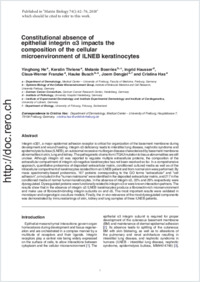Constitutional absence of epithelial integrin α3 impacts the composition of the cellular microenvironment of ILNEB keratinocytes
- He, Yinghong Department of Dermatology, Medical Center – University of Freiburg, Faculty of Medicine, Freiburg, Germany
- Thriene, Kerstin Department of Dermatology, Medical Center – University of Freiburg, Faculty of Medicine, Freiburg, Germany
- Boerries, Melanie Systems Biology of the Cellular Microenvironment Group, Institute of Molecular Medicine and Cell Research, University Freiburg, Germany - German Cancer Consortium, German Cancer Research Center, Heidelberg, Germany
- Hausser, Ingrid Institute of Pathology, University Hospital Heidelberg, Germany
- Franzke, Claus-Werner Department of Dermatology, Medical Center – University of Freiburg, Faculty of Medicine, Freiburg, Germany
- Busch, Hauke Systems Biology of the Cellular Microenvironment Group, Institute of Molecular Medicine and Cell Research, University Freiburg, Germany - Institute of Experimental Dermatology and Institute Experimental Dermatology and Institute of Cardiogenetics, University of Lübeck, Germany
- Dengjel, Jörn Department of Dermatology, Medical Center – University of Freiburg, Faculty of Medicine, Freiburg, Germany - Department of Biology, University of Fribourg, Fribourg, Switzerland
- Has, Cristina Department of Dermatology, Medical Center – University of Freiburg, Faculty of Medicine, Freiburg, Germany
-
01.12.2018
Published in:
- Matrix Biology. - 2018, vol. 74, p. 62-76
English
Integrin α3β1, a major epidermal adhesion receptor is critical for organization of the basement membrane during development and wound healing. Integrin α3 deficiency leads to interstitial lung disease, nephrotic syndrome and epidermolysis bullosa (ILNEB), an autosomal recessive multiorgan disease characterized by basement membrane abnormalities in skin, lung and kidney. The pathogenetic chains from ITGA3 mutation to tissue abnormalities are still unclear. Although integrin α3 was reported to regulate multiple extracellular proteins, the composition of the extracellular compartment of integrin α3-negative keratinocytes has not been resolved so far. In a comprehensive approach, quantitative proteomics of deposited extracellular matrix, conditioned cultured media as well as of the intracellular compartment of keratinocytes isolated from an ILNEB patient and from normal skin were performed. By mass spectrometry-based proteomics, 167 proteins corresponding to the GO terms “extracellular” and “cell adhesion”, or included in the “human matrisome” were identified in the deposited extracellular matrix, and 217 in the conditioned media of normal human keratinocytes. In the absence of integrin α3, 33% and 26% respectively were dysregulated. Dysregulated proteins were functionally related to integrin α3 or were known interaction partners. The results show that in the absence of integrin α3 ILNEB keratinocytes produce a fibronectin-rich microenvironment and make use of fibronectin-binding integrin subunits αv and α5. The most important results were validated in monolayer and organotypic coculture models. Finally, the in vivo relevance of the most dysregulated components was demonstrated by immunostainings of skin, kidney and lung samples of three ILNEB patients.
- Faculty
- Faculté des sciences et de médecine
- Department
- Département de Biologie
- Language
-
- English
- Classification
- Biological sciences
- License
-
License undefined
- Identifiers
-
- RERO DOC 323793
- DOI 10.1016/j.matbio.2018.07.001
- Persistent URL
- https://folia.unifr.ch/unifr/documents/307350
Statistics
Document views: 125
File downloads:
- pdf: 254
